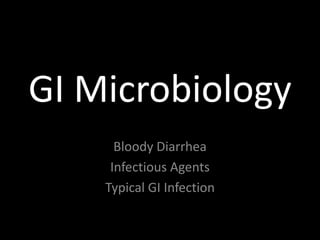
Gi micro boards bugs
- 1. GI Microbiology Bloody Diarrhea Infectious Agents Typical GI Infection
- 2. Bloody Diarrhea • There are more than 75 causesofbloody diarrhea. • Can you name some of the common ones???? • Salmonella • Ulcerative Collitis • E. Coli (EHEC & EIEC) • Crohn’s Disease • Entamoeba (protazoa) • Campylobacter • Ischemia • Shigella • Drug Induced • YersiniaEnterocolitica • Chemo/Radiotherapy • C. difficle • CMV w/ HIV • Neoplasm • Bloody Diarrhea is SEECSY (sexy)
- 3. Bloody Diarrhea • What do all these have in common? • They all attack the cells of the GI tract (mostly large intestine) and cause them to slough off. • What questions will you ask your patient to tell them apart? • Acute vs. Chronic • Family disease history (cancer, IBD, etc) • Previous attacks • Abdominal Pain, Vomiting, Fever, Weight • Appearance: mucus, pus, color Loss, Anal Itch • Recent Food and drug intake • Painful joints, Back pain, Eye problems, • Meal Sharing – are they sick too Skin lesions • Recent Travel – overseas, underdeveloped• Symptoms of Iron Deficiency • Patient History (cancer, chemo, surgery, HIV, etc)
- 4. Bloody Diarrhea – Infectious Agents • Salmonella spp. Cafeteria/restaurant outbreaks, family gatherings. contaminated food/water (eggs/poultry). Summer months. Very young and very old. Prodrome of fever, headache, myalgia and abdominal cramps. Fecal WBCs (and RBCs, but not so much). • EHEC contaminated food/water, meat, outbreaks in institutions, day care. Fever, abdominal cramps, very bloody stools. Can be complicated by HUS (hemolytic uremic syndrome) and TTP (Thrombotic thrombocytopenic purpura. Produces Shiga-like toxin to cause systemic effects as well. Fecal WBCs and RBCs. • EIEC Shiga-like dysentery with blood and mucus, due to E. coli that invade epithelial cells of people of all ages, also producing vomiting, fever and chills. A few children develop HUS • E.histolytica contaminated food/water, travel in developing countries. Sudden onset fever, abdominal cramps, bloody diarrhea (amoebic dysentery). Fecal WBCs and RBCs. • Campylobacter spp. Most common diagnosed cause of bacterial diarrhea. Backpacker’s diarrhea; contaminated food/water. Summer months. ~1wk duration. Very young children, and young adults. Prodrome of fever, headache, myalgia and abdominal cramps. Fecal WBCs and RBCs. • Shigellaspp. person to person spread; within families, day care. Sudden onset fever, headache, myalgia, abdominal pain. Produces Shiga toxin. Fecal WBCs and RBCs • Y. enterocoliticaperson to person and contaminated food/water, day care outbreaks. Fever, RLQ abdominal pain. Mimics appendicitis. Fecal WBCs and RBCs. • C. difficileafter treatment with Antibiotics (especially clindamycin) and antimotility agents, and especially in hospital setting. Fever, abdominal pain, bloody stools with specific odor. Fecal WBCs and RBCs. Toxin destroys colonic mucosa.
- 5. Watery Diarrhea – Infectious Agents • ETEC: Traveler’s Diarrhea, produces ST (heat stable) and LR (heat labile) toxins • VibrioCholerae: “Cholera,” comma-shaped organism, rice-water diarrhea • C. perfringens: also causes gas gangrene • Protozoa: Giardia and Cryptosporidium • Viruses: Rotavirus, adenovirus, norwalk virus (norovirus) • Which of these is the leading cause of severe infantile diarrhea?? Rotavirus!
- 6. Bloody Vs. Watery Diarrhea Bloody Diarrhea Invasive organisms: Salmonella, Shigella and EIEC enter enterocytes, multiply in their cytoplasm, and then spread to the next enterocytes while the previous die by necrosis (necrosis --- so bleeding --- and reactive secretion of water and mucus) Toxins which lead to necrosis: Shigelladysenteriae with shiga toxin which inhibits protein synthesis thus leading to the cell death (necrosis), also EHEC which has shiga-like toxin Watery Diarrhea - without invasion and necrosis Bacteria cover absorptive surfaceso less is absorbed from the intestines Decreased number of intestinal villi Increase water and electrolytes secretion(due to toxins) -Vibriocholerae with cholera toxin, -ETEC with LT-I toxin which is like cholerae-toxin and acts via cAMP, -ETEC with St-a toxin which acts via cGMP
- 7. General Features of GI Bacteria Bacteria Gram Stain Shape Extra Salmonella Gram Negative Rod Lactose negative, flagellar motility E. Coli Gram Negative Rod EHEC: HUS,shiga like toxin EIEC: Invades colon ETEC: Traveler’s Diarrhea, LT and ST toxins Campylobacter Gram Negative Comma OxidasePositive, growth at 42o C (jejuni) or S Shigella Gram Negative Rod Lactose Negative, low ID50, Shiga toxin YersiniaEnterocol Gram Negative Rod Pseudo-appendicitis itica VibrioCholerae Gram Negative Comma Rice-water diarrhea Clostridium Gram POSITIVE Rod, Also causes Gas Gangrene Perfringens Spore Clostridium Gram POSITIVE Rod, Pseudomembranous Colitis, Deficle Spore Antibiotic Associated Diarrhea
- 8. General Features ofOther Bugs Virus Genome Envelope Rotavirus ds-RNA No #1 cause of fatal diarrhea in children Adenovirus ds-DNA No Mostly URT infections Norovirus ss-RNA No Epidemic gastroenteritis Treatment??? HYDRATION!!!! Usually self-limiting, only last a few days Parasite Disease Transmission Treatment EntamoebaHisto Amebiasis: dysentry, Cysts in water Metronidazole and lytica RUQ pain, liver Iodoquinol abscess Cryptosporidium Severe Diarrhea in Cysts in water Prevention by filtering immuno, mild city supplies otherwise Giardia Giardiasis: foul- Cysts in water Metronidazole smelling fatty diarrhea
- 9. Gastroenteritis • WIKI: aka gastric flu or stomach flu, is the inflammation of the gastrointestinal tract, involving both the stomach and the small intestine and resulting in acute diarrhea, nausea, vomiting, cramps, etc. It is typically self-limiting. • Norovirus is the leading cause, Rotavirus is second but causes more deaths (more severe) Colitis • WIKI: refers to an inflammation of the large intestine • Can be caused by bacterial infections, ischemia, IBD. • Abdominal pain, loss of appetite, fatigue, diarrhea (often bloody), cramping, fever, distention
- 10. GI Host Defense GI tract barriers include the acid pH of the stomach and the antibacterial activity of pancreatic enzymes, bile, and intestinal secretions. Peristalsis and the normal loss of epithelial cells remove microorganisms. If peristalsis is slowed (eg, because of drugs such as belladonna or opium alkaloids), this removal is delayed and prolongs some infections, such as symptomatic shigellosis. Normal bowel flora can inhibit pathogens; alteration of this flora with antibiotics can allow overgrowth of inherently pathogenic microorganisms (eg, Salmonella typhimurium) or superinfection with ordinarily commensal organisms (eg, Candida albicans).